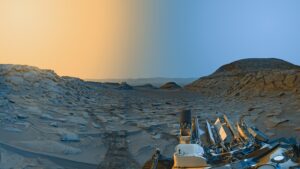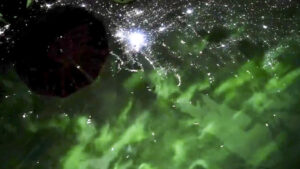Judy Schmidt, a Modesto, California-based citizen scientist with no formal background in astronomy, has collaborated with professionals to produce two stunning new images of Jupiter.
Schmidt created the renderings of the solar system’s largest planet using data from NASA’s James Webb Space Telescope.

Image: NASA, European Space Agency, Jupiter Early Release Science team. Image processing: Judy Schmidt
Because all data NASA collects is public domain, members of the public can access it as an (extremely cool) hobby. Schmidt’s interest in processing space images got a boost 10 years ago when she took third place in a European Space Agency contest.
Since then, she’s collaborated with scientists to process images of all sorts of cosmic objects, including globular clusters and nebulae.

Left: Judy Schmidt. Right: an example of Schmidt’s work as an image processor — Minkowski’s Butterfly nebula. Photo: NASA
Unexpectedly beautiful (and beneficial)
Amateur as she may be, Schmidt’s work passed the pros’ litmus test.
“We hadn’t really expected it to be this good, to be honest,” said planetary astronomer Imke de Pater of the University of California, Berkeley. “It’s really remarkable that we can see details on Jupiter together with its rings, tiny satellites, and even galaxies in one image,” she said.
The astounding details are helping scientists look into the depths of Jupiter’s famous storms and clouds.
“The brightness here indicates high altitude — so the Great Red Spot has high-altitude hazes, as does the equatorial region,” said Heidi Hammel, a Webb scientist. “The numerous bright white ‘spots’ and ‘streaks’ are likely very high-altitude cloud tops of condensed convective storms [read: thunderstorms].”
The Webb Telescope’s Near-Infrared Camera (NIRCam) gathered the data for the images using three specialized infrared filters. The filters map infrared light to visible colors. Each filter uses a different set of colors to uncover different information.
One of the images even reveals Jupiter’s extremely faint rings, as well as two of its moons (Amalthea and Adrastea) and several galaxies.

Image: NASA, ESA, CSA, Jupiter ERS Team. Image processing by Ricardo Hueso (UPV/EHU) and Judy Schmidt
To boldly go, etc.
The James Webb Telescope made a splash recently when NASA released new images of seemingly endless galaxies. The Webb Telescope mission is a joint effort between NASA, the European Space Agency, and the Canadian Space Agency.
It’s part of what looks like a new phase of human exploration of our universe. NASA is continuing the trend with the Artemis program, which expects to land astronauts on the moon as soon as 2025.






